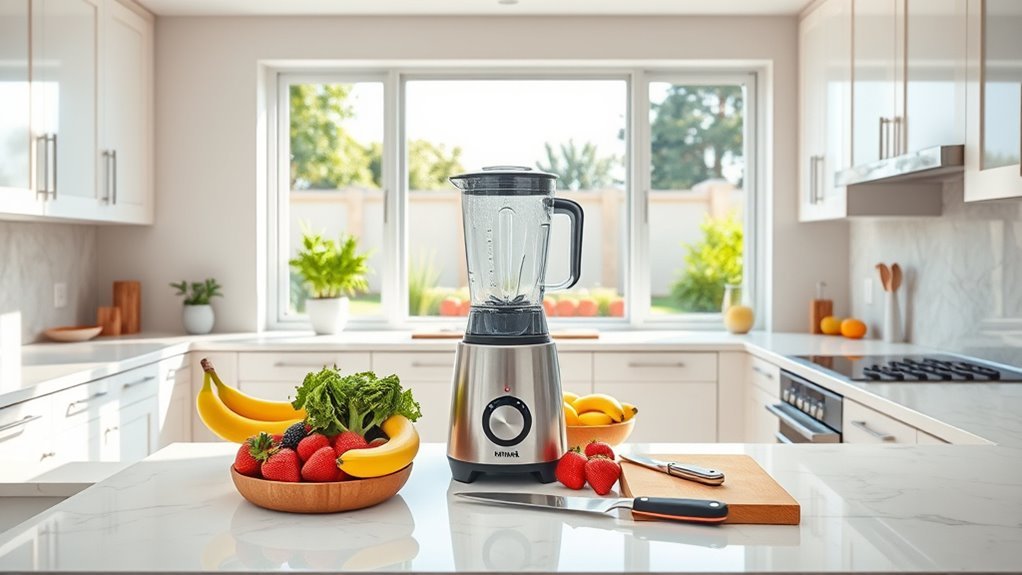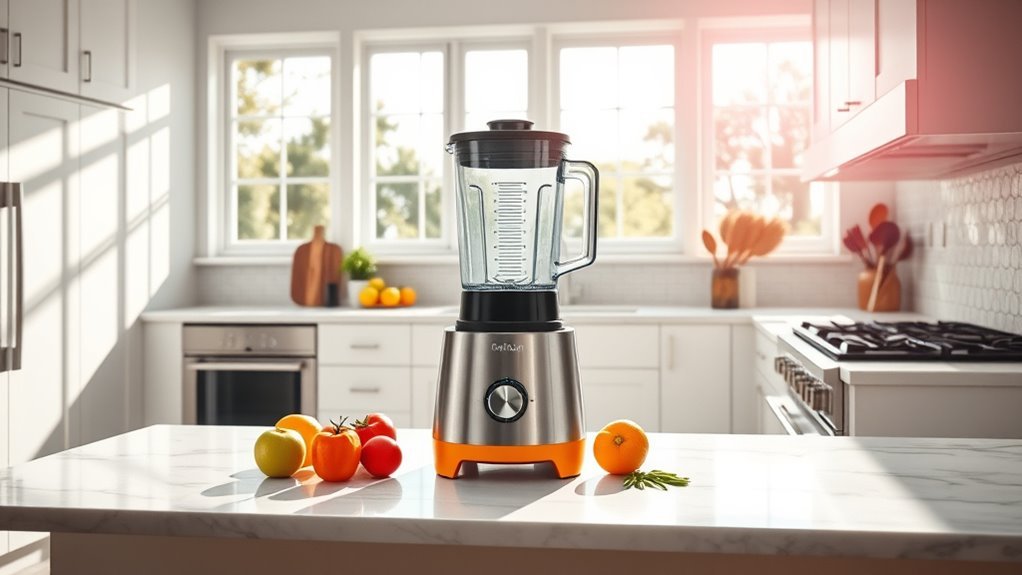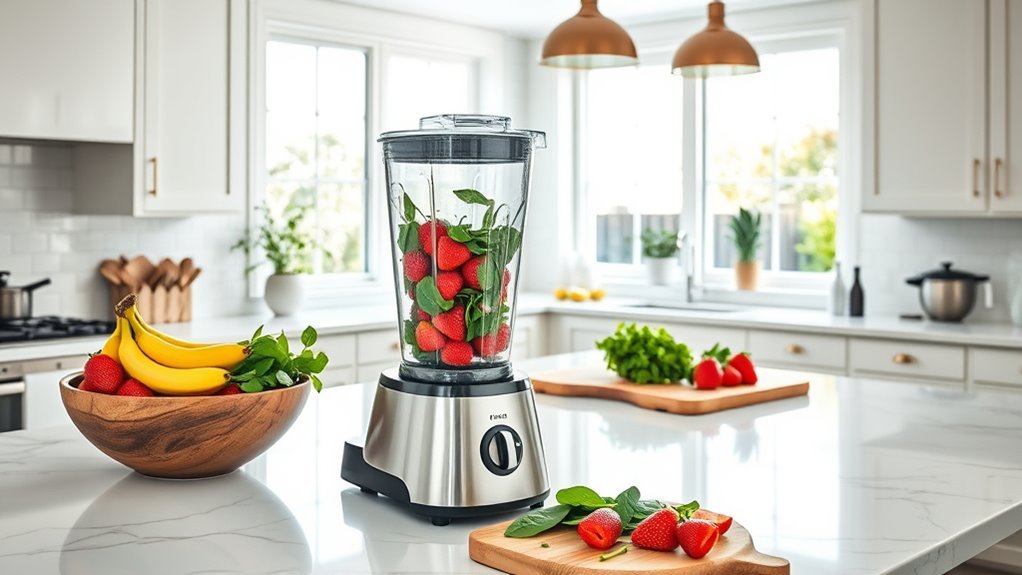Modern blender blade designs aren’t just about chopping – they’re critical safety systems. We rely on features like enclosed blade housings, intelligent interlocking mechanisms, and specialized geometries to prevent accidents. Today’s designs combine stainless steel durability with rounded tips and protective guards to eliminate risks while maximizing performance. Regular maintenance of these safety features isn’t optional – and that’s just scratching the surface of blender blade engineering.
Essential Safety Features of Modern Blender Blade Designs

When it comes to modern blender safety, blade design serves as the first line of defense against potential injuries.
We’re seeing revolutionary safety features in today’s durable blenders that make sharp blades less threatening without sacrificing performance. The blades housing system we’ve come to trust completely encases cutting elements, while intelligent interlocking mechanisms prevent accidents by ensuring the blender won’t operate without proper lid placement.
Let’s be clear: modern blender designs aren’t just about power – they’re engineered with your safety in mind.
We’re particularly impressed with dual-directional blade movements that eliminate unblended chunks, reducing the temptation to reach in while blending. These innovations, combined with wear-resistant stainless steel construction, deliver the perfect balance of safety and functionality you deserve. Additionally, the design of high-performance blenders often features powerful motors that enhance blending efficiency while maintaining safety standards.
Understanding Different Blade Materials and Their Safety Impact
The selection of blade materials directly impacts both performance and user safety in modern blenders. We’re seeing stainless steel dominate the market because it’s corrosion-resistant and durable – precisely what’s needed to prevent dangerous blade failures during operation.
Let’s examine the safety impact: High-quality blade designs with titanium coatings and composite materials offer superior strength while keeping weight manageable. Thicker, more robust blades resist bending and breaking, eliminating the risk of sharp fragments becoming projectiles.
Smart manufacturers are incorporating rounded tips and safety guards into their designs to prevent unintentional cuts. These safety guidelines aren’t just recommendations – they’re essential features that protect users during operation and cleaning. Additionally, high-performance blenders often feature advanced blade designs that enhance both efficiency and safety for users.
When it comes to blade materials, there’s no compromising on safety standards.
How Blade Geometry Affects User Protection

Building on our material insights, blade geometry plays an equally vital role in user protection.
We’ve cracked the code on how specific blade designs maximize safety while maintaining blending efficiency.
Let’s examine the key geometric features that reduce risk:
- Rounded blade tips eliminate unnecessary sharp edges, protecting you during cleaning and handling.
- Staggered blade positioning prevents ingredient chunks, so you won’t need to reach in while blending.
- Precise angle calculations minimize splatter, keeping ingredients where they belong – in the jar.
- Enclosed blade systems create a protective barrier between you and cutting surfaces.
These safety features aren’t just smart design – they’re indispensable protection.
When blade geometry aligns with user safety, we get the perfect blend of performance and peace of mind.
The Role of Blade Guards in Preventing Accidents
Safety-conscious manufacturers know blade guards represent our most critical line of defense against blender accidents.
We can’t stress enough how these guards prevent accidental contact with sharp edges while ensuring proper splatter containment during operation.
Let’s be crystal clear: modern blade guards aren’t just plastic barriers.
They’re sophisticated components integrated with interlocking systems that won’t let your blender run unless everything’s locked in place.
That’s next-level injury prevention right there.
But here’s the kicker – even the best safety protocols mean nothing if you’re not maintaining your equipment.
We insist on regular maintenance checks of your blade guards.
Look for wear, cracks, or loose components.
When these fail, you’re just one smoothie away from a potential accident.
Proper Blade Maintenance for Enhanced Safety

Because proper blade maintenance forms the cornerstone of blender safety, we’ve got to tackle this head-on.
Following manufacturer’s guidelines isn’t just bureaucratic nonsense – it’s your first line of defense against accidents. Let’s cut through the fluff and focus on what really matters.
- Inspect your blender blades regularly for chips or dullness – compromised blades are accidents waiting to happen.
- Master proper cleaning techniques after each use, because food buildup isn’t just gross, it’s dangerous.
- Replace worn blades immediately – don’t wait for them to fail catastrophically.
- Always unplug before maintenance – it’s amazing how many people skip this critical safety standard.
Advanced Engineering Solutions in Blade Protection
Modern engineering has revolutionized blender safety through innovative blade protection systems that’ll make you wonder how we ever survived without them.
We’re now seeing advanced guards and enclosures that prevent accidental contact with blades, while interlocking mechanisms guarantee the lid stays put during operation.
Let’s talk durability: today’s blades use high-tensile materials that resist corrosion and failure.
Smart blade configurations boost blending efficiency while preventing those annoying wobbles that could send your smoothie flying.
Trust us, these aren’t your grandmother’s blender blades.
Regulatory Standards for Blender Blade Safety
While blending technology keeps evolving, regulatory standards haven’t wavered in their rigorous oversight of blade safety.
We’re seeing strict enforcement of injury prevention measures across the industry, with organizations like the Occupational Safety and Health Administration leading the charge.
Here’s what you need to know about current regulatory standards:
- Blades must feature guards and enclosures to prevent accidental contact.
- Performance standards require extensive blade retention testing.
- Interlocks are mandatory to stop operation when lids aren’t secure.
- Regular safety inspections must verify blade integrity.
These compliance requirements aren’t just bureaucratic red tape – they’re your guarantee that every push of that blend button won’t end in disaster.
Smart design meets stringent oversight, keeping your smoothie-making adventures safely contained in the pitcher where they belong.
Frequently Asked Questions
What Are the Safety Concerns of a Blender?
Like a tiny tornado of trouble, we must watch for blender accidents, blade injuries, motor overheating, electrical hazards, child safety, food splatter, and proper cleaning when using these kitchen tools.
What Is the Safe Handling Technique for Blender?
We’ll protect ourselves by following proper blender safety tips: unplug before cleaning, maintain sharp blades, secure placement, read user manuals, and keep children away from the operating appliance.
What Are Three Important Safety Factors You Must Follow When Working With Blenders and Food Processors?
With 85% of kitchen accidents involving powered appliances, we’ll stay safe by always checking blade design integrity, following the user manual’s safety features, and maintaining proper ergonomic handling during food preparation.
What Are the Safety Rules When Using a Hand Blender?
We must unplug our hand blender before cleaning, maintain a firm grip during operation, avoid water submersion, keep fingers away from blades, and follow the user manual’s safety precautions and cleaning guidelines.

